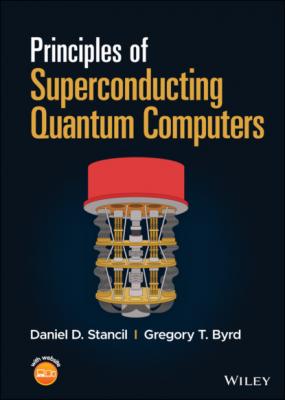Principles of Superconducting Quantum Computers. Daniel D. Stancil
Чтение книги онлайн.
Читать онлайн книгу Principles of Superconducting Quantum Computers - Daniel D. Stancil страница 14
 2nd Row 1st Column 1 2nd Column negative 1 3rd Column 1 4th Column negative 1 3rd Row 1st Column 1 2nd Column 1 3rd Column negative 1 4th Column negative 1 4th Row 1st Column 1 2nd Column negative 1 3rd Column negative 1 4th Column 1 EndMatrix Start 4 By 1 Matrix 1st Row 1 2nd Row 0 3rd Row 0 4th Row 0 EndMatrix equals one-half Start 4 By 1 Matrix 1st Row 1 2nd Row 1 3rd Row 1 4th Row 1 EndMatrix period"/> (1.45)
2nd Row 1st Column 1 2nd Column negative 1 3rd Column 1 4th Column negative 1 3rd Row 1st Column 1 2nd Column 1 3rd Column negative 1 4th Column negative 1 4th Row 1st Column 1 2nd Column negative 1 3rd Column negative 1 4th Column 1 EndMatrix Start 4 By 1 Matrix 1st Row 1 2nd Row 0 3rd Row 0 4th Row 0 EndMatrix equals one-half Start 4 By 1 Matrix 1st Row 1 2nd Row 1 3rd Row 1 4th Row 1 EndMatrix period"/> (1.45)
Note that the resulting state vector can be decomposed into a sum of all of the two-qubit basis states:
or alternatively
We see that application of Hadamard gates to each qubit creates an equally weighted superposition of all possible basis states. This is often a very useful starting point for a quantum calculation.
Although the matrix representation can be helpful in understanding the operations, calculations can often be done more compactly once the effect of the gates are understood. For example, we could write H ⊗ H |00⟩ = H ⊗ H |0⟩ |0⟩, apply the Hadamard gates to each qubit, and simplify:
We conclude this section with a comment on notation. A more compact notation is often used for situations where the same operator is applied across multiple qubits; i.e., H⊗H is alternatively written H⊗2, H⊗H⊗H=H⊗3, etc.
1.5.3 Controlled-NOT
The gates that we have considered so far involve operations that are independently applied to separate qubits—there is no qubit–qubit interaction. If we are to entangle two qubits, then we need classes of gates where the operation on one qubit depends on the state of another. One of the most important such gates is the controlled-NOT, or CNOT gate. For this gate, one of the input qubits is the “control,” and the other is the “target.” If the control qubit is zero, then nothing is done to the target qubit, but if the control qubit is one, then the target qubit is flipped. For example, if the right qubit in our notation is the control and the left qubit is the target, then the CNOT gate transforms the basis states as follows:
The effect of a CNOT can be compactly represented by UCN|t⟩|c⟩=|c⊕t⟩|c⟩, where ⊕ represents exclusive-OR or modulo-2 addition (e.g., 0+1=1, but 1+1=0). The matrix representation of the CNOT gate is
and the circuit symbol is shown in Figure 1.4.
Figure 1.4 Symbol for a CNOT gate, and its effect on basis states.
It is worth noting at this point that we are putting the least-significant qubit at the top of a circuit diagram, and on the right on the state labels used with kets. This labels states with the natural binary order. However, there are different conventions in use, and this can be a point of confusion. Some authors put the top-most qubit in a circuit diagram on the left when they label kets. In this alternate notation, UCN′|c⟩|t⟩=|c⟩|c⊕t⟩ so that
The matrix representation of the CNOT gate in this alternate convention is
We will consistently use the first convention, with the least-significant qubit (top-most on a circuit diagram) on the right when writing state labels.
1.6 Bell State
Consider the circuit shown in Figure 1.5. The circuit can be described mathematically